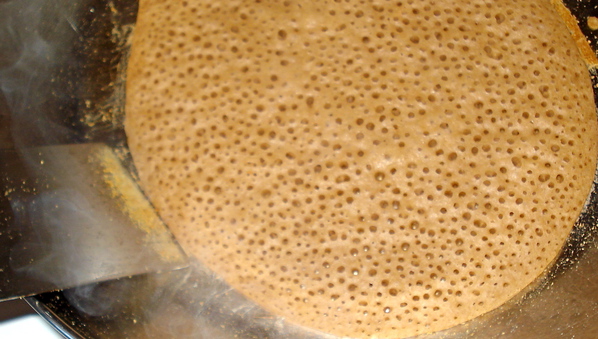- The best injera is usually made from an expensive grain called teff
- But barley is cheaper and a new variety tastes just as good in tests
- An earlier, purple barley variety proved unpopular
Now, researchers have bred barley that rivals teff for making injera, according to research published in Crop Science last month (1 July).
Teff is a low-yield crop in Ethiopia, making it expensive, says Addis Abraha, a researcher based at Ethiopia's Mekelle University and an author of the research. He adds that the preference for teff makes it twice the price of injera made from other cereals.
"The search for an inexpensive grain such as barley as a substitute to make injera [of a] comparable quality became very important," Abraha tells SciDev.Net.
The researchers from Ethiopia and Norway tested 11 barley varieties grown in the Tigray region, 800 kilometres north of the capital Addis Ababa. Barley is widely cultivated in Tigray, but yields are low.
Abraha says the research produced three improved varieties. The first, named Himbil, was officially released in 2011. Two other varieties were released in 2012.
The researchers bred the varieties with local farmers. In tests, 20 local people aged from 36 to 72 tasted the different types of barley injera and scored them for qualities such as texture, taste, suppleness and the quality of the bread's surface.
Himbil scored high on taste when compared to teff injera, but faired poorly on colour because of its purple tinted flowers.
"Ethiopians want their injera white," says Abraha.
The researchers then crossed Himbil with Saesa, another high-scoring barley variety which is white, released in 2012. This variety proved a hit with farmers in the region, owing to better, stable yields, which points to wider acceptance, he says.
Åsmund Bjørnstad, a researcher on the project from the Norwegian University of Life Sciences, says people do not yet associate barley with good injera, and they may need convincing.
But Adugna Woldesemayat, a plant breeder at the South African National Bioinformatics Institute (SANBI), says the local community may not need much convincing, because barley has been used for a variety of purposes, including injera-making, for centuries.
But it may be more of a challenge in other parts of the country where teff dominates.
"[The improved variety] is a better option for communities that need improved barley. However, this does not mean that barley will substitute for teff injera in most other parts of Ethiopia, where teff is dominantly grown," he tells SciDev.Net.
This article has been produced by SciDev.Net's Sub-Saharan Africa desk.
Link to full paper in Crop Science
http://www.scidev.net


No comments:
Post a Comment